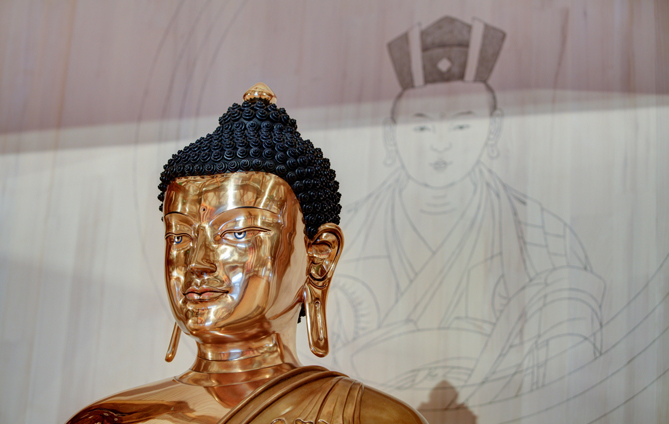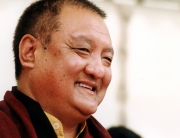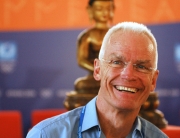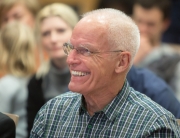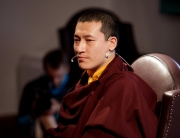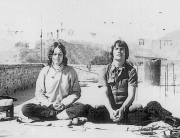Every single person in the world is looking for happiness, but most people seek it in the outer world – in fame, career, partnership, etc. One cannot deny that these things give us pleasure, but since everything conditioned will fall apart, these sources of happiness are not lasting. The following article is an excerpt of a lecture by Karola Schneider given during a course of Lama Ole Nydahl in 1995 in San Francisco, where over 400 people from the United States and Europe participated. Karola Schneider, who has been a student of Lama Ole Nydahl since 1979, was asked on this occasion to give a short lecture on the meaning of Buddhist refuge.
Taking refuge is something that all beings do. It is our search for happiness, security, for something we can rely on. For Buddhists, taking refuge is a constant practice, and is far more than a ceremony which takes place once. Rather, it is like a thread which weaves a line through our lives. Taking refuge is the gateway into the Buddhist practice. There are four levels of refuge: outer, inner, secret and absolute. These levels correspond to our more and more deepening understanding.
The outer level of refuge is taken by all Buddhist traditions. It is the refuge in Buddha, the Enlightened One, in the dharma, the Buddha’s teachings, and in the sangha, the practitioners. They are called the three jewels, which means, that, since our wishes for happiness are granted, taking refuge in them is like finding a wish-fulfilling jewel. Refuge in the Buddha in this context means to understand his life story, which gives us a great inspiration for our own path. What made the young prince Gautama so determined that he gave up his royal lifestyle? He did it because he deeply understood impermanence – that everything conditioned would eventually fall apart. Due to this understanding, he persistently searched for something unconditioned, which he later explained as the “true nature of our mind.” The word for biography in Tibetan is “nam thar,” which literally means “complete liberation.” By studying the life stories of enlightened masters we can understand the steps of the Buddhist path.
Buddha was a normal person before his enlightenment, like you and me. Like he, we have to ask ourselves what we want from life, which goals we have, and what we wish to build upon. Otherwise our activities are not goal-directed. The best attitude for our practice is the wish to liberate all beings from suffering and to give them the greatest happiness, the experience of the true nature of mind.
Taking refuge in the second jewel, the dharma, means not to harm others and to use the methods Buddha gave. Since he gave different methods for different students, there is a wide variety of skillful means to tame our minds. We can understand this vast range of methods like a big pharmacy. We do not need every method; we can just use the one that helps with our ailment.
The third jewel is the sangha. Sometimes sangha is explained as those practitioners who have already reached levels of liberation. But our friends whom we meet and work with in our centers are also very important for our path. How can we develop without friends on the path and without a center to go to? To come together and practice is something very precious. We can work together, learn from each other, and in this way we can train our qualities and learn something about our behavior. The people in the sangha mirror our distorted perceptions so that we can overcome them more easily.
The inner level of refuge is connected with the Diamond Way, the practice of the Vajrayana. It is the refuge in the “three roots,” which are the lama, the yidams (buddha aspects), and the protectors. The lama is the root of blessing, the yidams are the roots of qualities and the protectors are the roots of activity.
What does blessing mean? It is the teacher’s ability to give us moments of insight -moments where we can look through all the veils which cover our mind and “see what cannot be seen.” This is possible only because we all have buddha nature. The teacher does not show us anything new, neither is he presenting us with insight. It is rather through the coming together of our own openness and the teacher’s blessing that we can grasp the true nature of our mind. The teacher opens the door and then we can be amazed. Actually, the teacher promises a lot when he is giving refuge. He promises to guide us on the path and to use all his skills to liberate us from suffering. For us in the beginning, taking refuge is more like a gift, which we can take, or not. As Buddha Shakyamuni said, “I have shown you the methods that lead to liberation but you should know that liberation depends upon you.” (From Journey to Enlightenment – The Life and World of Khyentse Rinpoche, Spiritual Teacher from Tibet). The teacher’s skills are embodied in the yidams. “Yi” means mind and “dam” means bond. Through those buddha aspects we get a bond to the true nature of our mind.
When I am listening to lectures of my teachers, I often ask myself how I would answer certain questions. In most cases my own answer would be different. Here you can see the difference between master and student. On liberated levels you not only have compassion, but also levels of insight. That means the answer is given according to the student’s needs. Sometimes the teacher will show himself as compassionate, sometimes as joyful, sometimes as peaceful, and sometimes as wrathful. These qualities are embodied in the different buddha aspects, the yidams. The protectors look very wrathful. They symbolize enlightened activity. With their blessing every single experience becomes a step on our path. They are surrounded by flames and hold all kinds of weapons in their hands. This means that they are cutting through negative emotions. From the skull-cups in their hands they drink blood, which is the blood of ego. When we take refuge in the yidams and the protectors we should not think of them as something separate from us, but try to understand them as an expression of the lama’s mind, which is not different from our own mind. They are an expression of the mind being empty and vivid simultaneously.
With this we come to the secret meaning of refuge. Here we understand that the lama is the essence of the refuge. His mind is Buddha, his speech is dharma, and his body is sangha. That is why in the Diamond Way, the Guru-Yoga meditation on the lama is of such importance. There are many sources in the scriptures which stress the importance of this practice, where we ask for the lama’s empowerment or blessing and then melt his mind with ours. Jamgon Kongtrul Lodro Thaye, the famous 19th century master, said, “If the teacher’s blessing comes together with the openness of the student, you will meet your mind like an old friend” (from Cloudless Sky.) In this context we are taught to see the lama as the Buddha. It is easy to claim being able to perceive our teacher as the Buddha, but it is difficult to really do it. Actually, the ability to do so is proportional to our inner development. For a beginner it is of more importance to first check the teacher for his qualities. It is difficult for us to judge whether he is enlightened or not, but we can observe his compassion, how consistently he works for the benefit of others, and whether his teachings are meaningful for us. When we are satisfied we can ask him for refuge, which is the starting point for our own development. By taking refuge we connect ourselves with all Buddhas. We start to remove the veils which obscure the true nature of mind and slowly understand that the actual lama is our mind. In the refuge ceremony a little bit of hair is cut. This expresses our wish to follow in the footsteps of Buddha Shakyamuni.
If we understand that we are not separate from the Buddha, from our teacher, this is the absolute meaning of refuge. By logical investigation we can see that nothing is truly existent whatsoever, not even our mind. But with investigation alone we will not be able to realize the true nature of mind. We need a direct and clear perception of our mind. Otherwise it is like describing the taste of a banana, but never eating one. The absolute refuge is our mind itself. It is the only thing we can rely on. The mind is described as being empty, yet vivid.
“Without an inside, without an outside,
Awareness arisen of itself, as wide as the sky,
Beyond size, beyond direction, beyond limits –
This utter complete openness:
Space inseparable from awareness.
Within that birthless, wide-open expanse of space,
Phenomena appear – like rainbows, utterly transparent.
Pure and impure realms, Buddha and sentient beings
Are seen brilliant and distinct.
….
To remain, day and night, in this state –
To enter this state easily – this is joy.
Emaho !
(Shapkar, Journey to Enlightenment p.92)
In Buddhism we have efficient methods and there are no doubts about reaching enlightenment if we practice.
Normally everybody is taking refuge in something. Some in a Mercedes, others in their families, in being rich, smart, young, etc. But if we look for something lasting, something beyond coming and going, then we can only trust our Buddha nature. Everything else in the world disappears. You may ask yourself, “why are there so many levels of refuge? Why isn’t just the absolute level explained?” The reason is that we cannot understand the absolute truth without having a strong basis. Therefore we undergo a step by step training in Buddhism. Practically this means first to practice the refuge meditation – repeating the refuge mantra 11,000 times. Through this daily repetition the meaning comes down from the head to the heart. Then we can do the Four Foundational Practices, where we first mentally develop the wish to liberate all sentient beings from suffering, then purify ourselves from physical, verbal and mental negativity and finally, after building strong positive impressions in us, we meditate on the Lama. I hope with this information you become inspired to practice more. Beginners can start right away with the refuge meditation, which is available in our centers.


